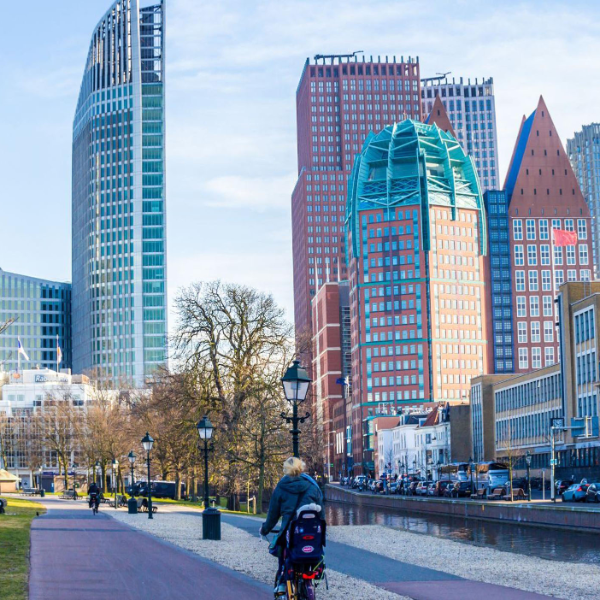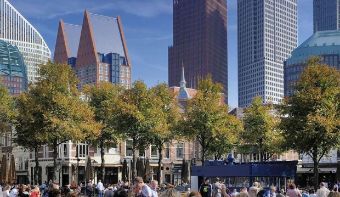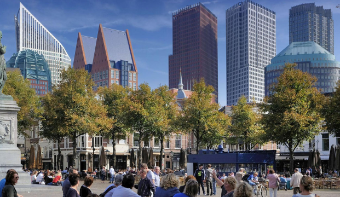The Hague’s climate targets

The Hague’s climate targets
Climate-neutral by 2030. This imposes an ambitious climate objective on the municipality of The Hague. By making its own real estate in the municipality more sustainable, the Central Government Real Estate Agency is also taking the lead in the energy transition. Witteveen+Bos advises the municipality and the national government on how these objectives can be achieved. Below is a brief glimpse into some of the projects.
EnergieRijk Den Haag
In the EnergieRijk Den Haag programme, Witteveen+Bos with partners DWA and Rebel, was commissioned by the Central Government Real Estate Agency and the municipality of The Hague to draw up an area-specific strategy in 2018, initially for making sixteen government buildings more sustainable. The programme now covers a million square metres of building space. With the EnergieRijk Den Haag Green City deal, a large-scale collaboration has been created between public and private partners. Together the strategy is being translated into visible and concrete projects. Witteveen+Bos is contributing in the area of renewable heat and smart buildings, by deploying the mass of all these buildings to accelerate innovations and scale up new projects. The ‘Trias Territoria’ design philosophy and the dynamic transition paths that we devised as early as 2017 are now being developed into a climate-neutral city. This is unique and something to be proud of.
CID and Binckhorst
The municipality has opted for the expected urban growth over the decades ahead to occur mainly within existing urban areas, including the Central Innovation District (CID) and the Binckhorst. CID is the area around Central Station, Hollands Spoor and Laan van NOI. More than 25,000 homes and 30,000 jobs will have been developed in the area by 2040. Many of the EnergieRijk Den Haag buildings are situated in the CID. The plans for the CID combine the existing construction and infrastructure in the area, with new very high-density construction. This entails the associated mobility and sustainability challenges. Witteveen+Bos assisted the municipality in drawing up a Structure Vision and associated Environmental Impact Assessment (EIA) for the CID until 2040. Among other things it examined what realising the (re)development plans could mean for the municipality’s CO2 emissions, for example. We worked with the municipality to develop a series of alternatives for the volume of the building assignment and accessibility, with more sustainable forms of mobility. Thus it became clear for instance that a mobility transition with associated public space is a precondition for an accessible, liveable and competitive CID. Opportunities and points for attention also became clearer for energy, sustainability, health and climate. Witteveen+Bos will continue working on the construction plans around Hollands Spoor station in 2020.
Regional mobility challenge
The mobility task is a regional one. Witteveen+Bos has conducted an exploratory study of realistic alternatives for the mobility issue for the joint regional partners, the municipality of The Hague and Leidschendam-Voorburg, the Rotterdam-The Hague metropolitan region, the province of South Holland and the Ministries of Infrastructure and Water Management and the Interior. The alternatives comprise a package of measures for high-grade public transport, cyclists and pedestrians, smart mobility, spatial use (including parking standards), station surroundings and logistics. The Exploratory Study was adopted by the regional partners in the autumn of 2019, and the plan will be further developed into a Preferred Alternative (VKA in Dutch) in 2020.
Climate-neutral Policy Campus
For part of the CID, the Policy Campus, Witteveen+Bos was commissioned by the municipality to write a strategic vision on how local sustainable energy sources can be used with ingenuity to make the built environment more sustainable. The result is the Energy Transition Vision Policy Campus. The building blocks of the energy transition and dynamic transition path approach developed by Witteveen+Bos have helped in assessing the potential sources of sustainable energy in the area, and in combining them optimally with the various types of buildings. A dynamic roadmap describes promising transition paths towards a climate-neutral Policy Campus. Not simply nailed down and staring blindly, but working flexibly and with focus.
HTO The Hague
The seasonal storage of thermal energy (heat) is an important challenge. In the current prospect, The Hague’s heat supply will be connected to residual heat from the Rotterdam port area using the ‘Leiding door het Midden’ (LdM) pipeline network. The year-round heat thus supplied is needed mainly in winter, creating opportunities for the application of seasonal heat buffering. High temperature storage (HTO in Dutch) offers the option of applying this on a large scale.
In working sessions this project brought together the most important stakeholders for the heat supply in The Hague, research institutes, permit issuers and policy-makers. The report elaborates on the technical preconditions, and preconditions from a permit perspective, that were discussed in the working sessions. The study shows that there is a high demand for large-scale heat storage in The Hague. This heat storage can be realised in the subsurface of The Hague if the HTO pilots (the TKI WINDOW project) yield favourable results, and if there is investment in better mapping of the geological ‘Formatie van Maassluis’.
More Information?




